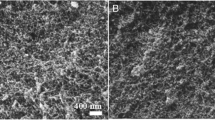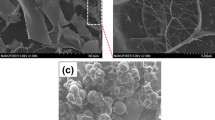Abstract
In this research, we proposed a synthesis of nano-silica aerogel (NSA, S1–S3) and nano-silica aerogel gelatin (NSA-G, S4–S6), which were hybrid aerogel by sol–gel method via ambient pressure drying. The aerogels’ backbone was modified by montmorillonite (MMT) in NSA and for NSA-G gelatin (G) and MMT were used to stabilize their building block. Also, free hydroxyl groups on their surface were changed to TMS-O and became more hydrophobic aerogels. The porosity results showed that the density of the optimum aerogels (S2 and S5) ranged from 0.084 to 0.047 g/cm3. It was also found that the hydrophobicity of the NSA-G aerogel decreased with increasing the content of gelatin into the silica aerogels. However, these aerogels were fully characterized by FTIR, FESEM, EDS, XRD, BET, and TGA/DTA analysis and they used as the adsorbent of Cu2+ and Ni2+ ions in aqueous media. The prepared aerogels effectively could remove these heavy metals from the aqueous media and NSA-G absorbent also illustrated a favorable result for adsorption. Also, the recyclability test for four adsorption–desorption of aerogels cycles was examined and they had a good effect even after the fourth cycle.

Highlights
-
The novel NSA and NSA-G as effective adsorbents were successfully prepared.
-
The adsorbents exhibited high sorption capacity for adsorbing Cu2+ and Ni2+ ions.
-
TGA/DTG of NSA-G exhibiting more thermal resistance in compare to NSA.
-
FESEM result indicating more compact structure for NSA-G with size 46–77 nm.










Similar content being viewed by others
References
Tian Z, Zhang L, Shi G, Sang X, Ni C (2018) The synthesis of modified alginate flocculants and their properties for removing heavy metal ions of wastewater. J Appl Polym Sci 135:46577
Nemati Dil N, Sadeghi M (2018) Free radical synthesis of nanosilver/gelatin-poly (acrylic acid) nanocomposite hydrogels employed for antibacterial activity and removal of Cu(II) me ions. J Hazard Mater 351:38–53
Efome JE, Rana D, Matsuura T, Lan CQ (2018) Experiment and modeling for flux and permeate concentration of heavy metal ion in adsorptive membrane filtration using a metal-organic framework incorporated nanofibrous membrane. Chem Eng J 352:737–744
Fakhre NA, Ibrahim BM (2018) The use of new chemically modified cellulose for heavy metal ion adsorption. J Hazard Mater 343:324–331
Baiya C, Nannuan L, Tassanapukdee Y, Chailapakul O, Songsrirote K (2019) The synthesis of carboxymethyl cellulose-based hydrogel from sugarcane bagasse using microwave-assisted irradiation for selective adsorption of copper (II) ions. Environ Prog Sustain Energy 38:S157–S165
Nguyen TC, Loganathan P, Nguyen TV, Kandasamy J, Naidu R, Vigneswaran S (2018) Adsorptive removal of five heavy metals from water using blast furnace slag and fly ash. Environ Sci Pollut R 25:20430–20438
Hasegawa G, Shimizu T, Kanamori K, Maeno A, Kaji H, Nakanishi K (2017) Highly flexible hybrid polymer aerogels and xerogels based on resorcinol-formaldehyde with enhanced elastic stiffness and recoverability: Insights into the origin of their mechanical properties. Chem Mater 29:2122–2134
Meador MAB, Alemán CR, Hanson K, Ramirez N, Vivod SL, Wilmoth N, McCorkle L (2015) Polyimide aerogels with amide cross-links: a low cost alternative for mechanically strong polymer aerogels. ACS Appl Mater Interfaces 7:1240–1249
Lin YF, Syu CR, Huang KW, Lin KYA (2019) Synthesis of Silica Aerogel Membranes using Low-Cost Silicate Precursors for Carbon Dioxide Capture. Chem Phys Lett 726:13–17
Meador MA, Miranda F, Van Keuls F (2016) Aerogel-based antennas for aerospace and terrestrial applications. In Google Patents. https://patents.google.com/patent/US10446920B1/en
Mi HY, Jing X, Huang HX, Peng XF, Turng LS (2018) Superhydrophobic graphene/cellulose/silica aerogel with hierarchical structure as superabsorbers for high efficiency selective oil absorption and recovery. Ind Eng Chem Res 57:1745–1755
Follmann HD, Oliveira ON, Lazarin-Bidóia D, Nakamura CV, Huang X, Asefa T, Silva R (2018) Multifunctional hybrid aerogels: hyperbranched polymer-trapped mesoporous silica nanoparticles for sustained and prolonged drug release. Nanoscale 10:1704–1715
Kabiri S, Tran DN, Azari S, Losic D (2015) Graphene-diatom silica aerogels for efficient removal of mercury ions from water. ACS Appl Mater Interfaces 7:11815–11823
Yun S, Guo T, Zhang J, He L, Li Y, Li H, Zhu X, Gao Y (2017) Facile synthesis of large-sized monolithic methyltrimethoxysilane-based silica aerogel via ambient pressure drying. J Sol-Gel Sci Technol 83:53–63
Feng Q, Chen K, Ma D, Lin H, Liu Z, Qin S, Luo Y (2018) Synthesis of high specific surface area silica aerogel from rice husk ash via ambient pressure drying. Colloids Surf Physicochem Eng Aspects 539:399–406
Kistler SS (1931) Coherent expanded-aerogels. J Phys Chem 36:52–64
Danks A, Hall S, Schnepp Z (2016) The evolution of ‘sol–gel’chemistry as a technique for materials synthesis. Mater Horiz 3:91–112
He S, Yang H, Chen X (2017) Facile synthesis of highly porous silica aerogel granules and its burning behavior under radiation. J Sol-Gel Sci Technol 82:407–416
Estella J, Echeverría JC, Laguna M, Garrido JJ (2008) Effect of supercritical drying conditions in ethanol on the structural and textural properties of silica aerogels. J Porous Mater 15:705–713
He F, Zhao H, Qu X, Zhang C, Qiu W (2009) Modified aging process for silica aerogel. J Mater Process Technol 209:1621–1626
Smith DM, Stein D, Anderson JM, Ackerman W (1995) Preparation of low-density xerogels at ambient pressure. J Non-Cryst Solids 186:104–112
Uchida N, Ishiyama N, Kato Z, Uematsu K (1994) Chemical effects of DCCA to the sol-gel reaction process. J Mater Sci 29:5188–5192
Kim CE, Yoon JS, Hwang HJ (2008) Synthesis of nanoporous silica aerogel by ambient pressure drying. J Sol-Gel Sci Technol 49:47
Gurav JL, Nadargi DY, Rao AV (2008) Effect of mixed catalysts system on TEOS-based silica aerogels dried at ambient pressure. Appl Surf Sci 255:3019–3027
Shi F, Wang L, Liu J (2006) Synthesis and characterization of silica aerogels by a novel fast ambient pressure drying process. Mater Lett 60:3718–3722
He S, Huang D, Bi H, Li Z, Yang H, Cheng X (2015) Synthesis and characterization of silica aerogels dried under ambient pressure bed on water glass. J Non-Cryst Solids 410:58–64
Smith DM, Maskara A, Boes U (1998) Aerogel-based thermal insulation. J Non-Cryst Solids 225:254–259
Liu S, Yao F, Oderinde O, Zhang Z, Fu G (2017) Green synthesis of oriented xanthan gum–graphene oxide hybrid aerogels for water purification. Carbohydr Polym 174:392–399
Ebisike K, Okoronkwo AE, Alaneme KK (2019) Adsorption of Cd (II) on chitosan–silica hybrid aerogel from aqueous solution. Environ. Technol Innovation 14:100337
Ebisike K, Okoronkwo AE, Alaneme KK (2018) Synthesis and characterization of Chitosan-silica hybrid aerogel using sol-gel method. JKSUS 32:550–554
Demilecamps A, Beauger C, Hildenbrand C, Rigacci A, Budtova T (2015) Cellulose–silica aerogels. Carbohydr Polym 122:293–300
Nistor MT, Vasile C, Chiriac AP (2015) Hybrid collagen-based hydrogels with embedded montmorillonite nanoparticles. Mater Sci Eng C 53:212–221
Jamilah B, Harvinder K (2002) Properties of gelatins from skins of fish-black tilapia (Oreochromis mossambicus) and red tilapia (Oreochromis nilotica). Food Chem 77:81–84
Wang B, Bai Z, Jiang H, Prinsen P, Luque R, Zhao S, Xuan J (2019) Selective heavy metal removal and water purification by microfluidically-generated chitosan microspheres: Characteristics, modeling and application. J Hazard Mater 364:192–205
Xu C, Shi S, Wang X, Zhou H, Wang L, Zhu L, Zhang G, Xu D (2019) Electrospun SiO2-MgO hybrid fibers for heavy metal removal: characterization and adsorption study of Pb(II) and Cu(II). J Hazard Mater 381:120974
Ma H, Wang S, Meng F, Xu X, Huo X (2017) A hydrazone-carboxyl ligand-linked cellulose nanocrystal aerogel with high elasticity and fast oil/water separation. Cellulose 24:797–809
Gong JL, Wang XY, Zeng GM, Chen L, Deng JH, Zhang XR, Niu QY (2012) Copper (II) removal by pectin–iron oxide magnetic nanocomposite adsorbent. Chem Eng J 185:100–107
Habila MB, Alothman ZA, El-Toni AM, Labis JP, Soylak M (2016) Synthesis and application of Fe3O4@SiO2@TiO2 for photocatalytic decomposition of organic matrix simultaneously with magnetic solid phase extraction of heavy metals prior to ICP-MS analysis. Talanta 154:539–547
Mahmoud ME, Fekry NA, El-Latif MMA (2016) Nanocomposites of nanosilica-immobilized-nanopolyaniline and crosslinked nanopolyaniline for removal of heavy metals. Chem Eng J 304:679–691
Vergili I, Beril Gönder Z, Kaya Y, Gürdağ G, Cavus S (2017) Lead removal from battery wastewater using synthesized poly (ethyleneglycol dimethacrylatemethacrylic acid) gel bead and poly(methacrylic acid) hydrogel. Polym Bull 74:2605–2624
Eid MS, Azzam GH, Eshaq AM, Rabie AA, Bakr AA, Abd-Elaal AE, El Metwally SM (2016) Preparation and characterization of chitosan-clay nanocomposites for the removal of Cu(II) from aqueous solution. Int J Biol Macromol 89:507–517
Fang X, Zhu S, Ma J, Wang F, Xu H, Xia M (2020) The facile synthesis of zoledronate functionalized hydroxyapatite amorphous hybrid nanobiomaterial and its excellent removal performance on Pb2+ and Cu2+. J Hazard Mater 392:122291
Wang H, Wang Z, Yue R, Gao F, Ren R, Wei J, Wang X, Kong Z (2020) Functional group-rich hyperbranched magnetic material for simultaneous efficient removal of heavy metal ions from aqueous solution. J Hazard Mater 384:121288
Alsohaimi IH, Wabaidur SM, Kumar M, Khan MA, Alothman ZA, Abdalla Abulhassan M(2015) Synthesis, characterization of PMDA/TMSPEDA hybrid nano-composite and its applications as an adsorbent for the removal of bivalent heavy metals ions Chem Eng J 270:9–21
Liu P, Jiang L, Zhu L, Guo J, Wang A (2015) Synthesis of covalently crosslinked attapulgite/poly (acrylic acid-co-acrylamide) nanocomposite hydrogels and their evaluation as adsorbent for heavy metal ions. J Indust Eng Chem 23:188–193
Srivastava N, Thakur AK, Shahi VK (2016) Phosphorylated cellulose triacetate–silica composite adsorbent for recovery of heavy metal ion. Carbohydr Polym 136:1315–1322
Zhao R, Li X, Sun B, Shen M, Tan X, Ding Y, Jiang Z, Wang C (2015) Preparation of phosphorylated poly acrylo nitrile-based nano fiber mat and its application for heavy metal ion removal. Chem Eng J 268:290–299
Anirudhan TS, Ramachandran M (2008) Synthesis and characterization of amidoximated polyacrylonitrile/organobentonite composite for Cu(II), Zn(II), and Cd(II) adsorption from aqueous solutions and industry wastewaters. Ind Eng Chem Res 47:6175–6184
Poureteda HR, Kazemi M (2012) Characterization of modified silica aerogel using sodium silicate precursor and its application as adsorbent of Cu2+, Cd2+, and Pb2+ ions. Int J Ind Chem 3:20–28
Qin L, Ge Y, Deng B, Li Z (2017) Poly (ethylene imine) anchored lignin composite for heavy metals capturing in water. J Taiwan Inst Chem 71:84–90
Huang CH, Hsieh TH, Chiu WY (2014) Evaluation of thermally crosslinkable chitosan-based nano fibrous mats for the removal of metal ions. Carbohydr Polym 116:249–254
Acknowledgements
The authors extend their appreciation to the Azad University of Arak-Iran for financial support of this work.
Author information
Authors and Affiliations
Corresponding author
Ethics declarations
Conflict of interest
The authors declare that they have no conflict of interest.
Additional information
Publisher’s note Springer Nature remains neutral with regard to jurisdictional claims in published maps and institutional affiliations.
Rights and permissions
About this article
Cite this article
Nematidil, N., Nezami, S., Mirzaie, F. et al. Fabrication and characterization of a novel nanoporous nanoaerogel based on gelatin as a biosorbent for removing heavy metal ions. J Sol-Gel Sci Technol 97, 721–733 (2021). https://doi.org/10.1007/s10971-020-05439-0
Received:
Accepted:
Published:
Issue Date:
DOI: https://doi.org/10.1007/s10971-020-05439-0




